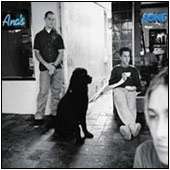Ana's Song (Open Fire)
"Ana's Song (Open Fire)" is a song by the Australian alternative rock band Silverchair. It was released in May 1999 as the second single from their third album, Neon Ballroom. The track earned Silverchair a Comet Award in Germany.
| "Ana's Song (Open Fire)" | ||||
|---|---|---|---|---|
 | ||||
| Single by Silverchair | ||||
| from the album Neon Ballroom | ||||
| Released | May 1999 | |||
| Format | CD, 7-inch | |||
| Recorded | 1998 | |||
| Genre | Alternative rock, grunge | |||
| Length | 3:42 | |||
| Label | Murmur | |||
| Songwriter(s) | Daniel Johns | |||
| Producer(s) | Nick Launay | |||
| Silverchair singles chronology | ||||
| ||||
Background
"Ana's Song (Open Fire)" is a single issued in May 1999 by Australian alternative rock band, Silverchair. It was written by the group's lead singer, Daniel Johns. In 1999, Johns announced that he had developed the eating disorder, anorexia nervosa, due to anxiety/depression.[1] Johns noted that the lyrics to "Ana's Song (Open Fire)" dealt with his disorder, where he would "eat what he needed ... to stay awake".[2] Ana is the nickname given to anorexia nervosa by people affected by it. He revealed that his eating problems developed from the time of Freak Show (May 1996) and when Neon Ballroom was written he "hated music, really everything about it", but felt that he "couldn't stop doing it; I felt like a slave to it."[3] Johns sought therapy and medication but felt "It's easier for me to express it through music and lyrics". Johns eventually overcame the disorder, realising that he would never be cured of the disease, but could live a fulfilled life by learning to cope with it.[1]
Reception
"Ana's Song (Open Fire)" peaked at No. 12 on Billboard's Modern Rock Tracks.[4] On the ARIA Singles Chart it reached No. 14.[5] According to 100 Best Australian Albums, by three Australian journalists, John O'Donnell, Toby Creswell and Craig Mathieson, "Ana's Song (Open Fire)" directly focused on Johns' eating disorder, "[it] became a hit all over the world and opened up for discussion the fact that males could also be affected by anorexia".[1]
Video
The music video was directed by Cate Anderson, who also made the band's video for the song "Emotion Sickness". Australian actress Sarah Aubrey played the girl at the sink washing her hands, while having a distorted image of their cleanliness through the mirror.
Reception
AllMusic critic Jason Anderson thought that "Ana's Song (Open Fire)" was one of the three highlights from Neon Ballroom.[6]
Track listing
|
Australian CD single (MATTCD086)
Australian limited 7-inch vinyl (MATTV086)
European CD single (6671072)
|
European CD single (with different cover) (6673455)
UK deleted CD single (6673452)
UK limited 7" picture disc (667345 7)
US promo CD (ESK42087)
|
Charts
| Chart (1999) | Peak position |
|---|---|
| Australia (ARIA)[5] | 14 |
| New Zealand (Recorded Music NZ)[7] | 34 |
| UK Singles (Official Charts Company)[8] | 45 |
| US Mainstream Rock (Billboard)[4] | 28 |
| US Alternative Songs (Billboard)[9] | 12 |
Certification
| Region | Certification | Certified units/sales |
|---|---|---|
| Australia (ARIA)[10] | Platinum | 70,000 |
|
^shipments figures based on certification alone | ||
References
- O'Donnell, John; Creswell, Toby; Mathieson, Craig (October 2010). "25: Silverchair – Neon Ballroom". 100 Best Australian Albums. Prahran, Vic: Hardie Grant Books. pp. 90–91. ISBN 978-1-74066-955-9.
- Fisher, Blair R (11 July 1999). "Silverchair Frontman Reveals Battle with Anorexia". Rolling Stone. Archived from the original on 30 January 2009. Retrieved 4 October 2011.
- Sams, Christine (6 June 2004). "Anorexia almost killed me: Daniel Johns". Sydney Morning Herald. Archived from the original on 14 October 2011. Retrieved 15 October 2011.
- "Silverchair Chart History (Mainstream Rock)". Billboard. Retrieved 15 June 2019.
- "Australian-charts.com – Silverchair – Ana's Song (Open Fire)". ARIA Top 50 Singles. Retrieved 15 June 2019.
- Anderson, Jason. "Neon Ballroom – Silverchair | Songs, Reviews, Credits, Awards | AllMusic". AllMusic. Retrieved 14 May 2019.
- "Charts.nz – Silverchair – Ana's Song (Open Fire)". Top 40 Singles. Retrieved 15 June 2019.
- "Official Singles Chart Top 100". Official Charts Company. Retrieved 15 June 2019.
- "Silverchair Chart History (Alternative Songs)". Billboard. Retrieved 15 June 2019.
- "ARIA Charts - Accreditations - 2020 Singles". ARIA. Retrieved 19 March 2020.